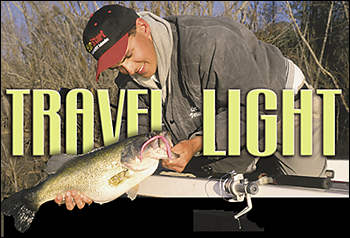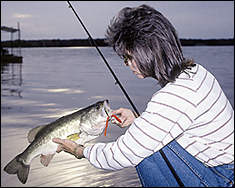
Downsizing your bass arsenal
will give you more bang for your buck.
By Matt Williams
Page 2
Wacky Worm
Perhaps the easiest to learn of the trick wormin' techniques is wacky worming. The simplicity stems from the fact that bass are apt to inhale a wacky worm at any time and rarely let go once they latch on.
As a rule, Martin says, most strikes will occur as the lure is falling around clumps of vegetation, stick-ups and bushes. Oftentimes you'll actually see the fish "flash" on the shallow sub-surface bait. But on occasion the strike will go undetected until the line feels mushy or starts moving off to one side or the other.
So named because of its odd action, the wacky worm is hooked directly through the egg sac with the point of the hook left exposed. In thick cover, you may opt for a hook with a built-in weed guard to lessen the odds of hanging up or fouling a cast.
A worm with a stiff body and no tail is highly-preferred over a limp one with a curly tail. A stiff worm opens and closes or "pulsates" better than a limp one, which naturally gives it a more enticing action. In addition to Trick Worms and other specially designed soft plastics, French fries and centipedes will double nicely as wacky worm style baits.
Hook size? A 2/0 hook is a good choice for wacky wormin' in water 3 feet deep and less. A heavier 3/0 may be required in deeper water where a faster fall is desired. A No. 7 barrel swivel and 12-inch leader are advised to prevent line twist.
Texas Rigging

Here is a prime example of what could be waiting underwater for just the right incentive to strike - in this case a wacky worm. Sometimes the only way to get bit on an overfished impoundment is to show 'em something different.
|
Vessel will utilize both the aforementioned rigs from time to time during the course of the year. But one of his favorite techniques for going after bass with spinning gear is with a lightweight Texas-rigged worm. He rigs his worm with a 1/8-ounce slip sinker and 2/0 offset hook with a very fine point to maximum penetration.
An equally small bait completes the microlight system. His favorite soft plastics are a Zoom Trick Worm, Finesse Worm, 3-inch Berkley Power Worm, 4-inch lizard, Zoom Baby Brush Hawg and centipede. Best colors are yellow, sour grape, watermelon, junebug and redbug.
In addition to boat houses and other shoreline structures, Vessel likes to fish the lightweight Texas rig in relation to scattered clumps of hydrilla, duck weed, lily pads and stump fields. He's gotten the best results using a semi-steady shaking retrieve as opposed to the hopping approach more commonly associated with Texas rigs.
Mojo Rig
At first glance the Mojo looks like a miniature Carolina-rig, but there is a major difference. The leader is not separate from the main line.
The heart of the Mojo rig is a tiny cylinder-shaped finesse weight that's designed so it can be slid up and down the main line above a 2/0 hook. The cylinder is hollow, except for a couple of soft rubber strips to hold the weight stationary.
Since the weight slides, it can be moved up and down the line to shorten and lengthen the leader quickly and easily.
Vessel says he's found the Mojo rig to be most effective just prior to and after the spawn. He likes to fish it slowly across the bottom in combination with a 1/16-ounce weight and 3-inch Power Craw or Zoom Finesse Worm. When fishing submerged vegetation, he'll use a slow, swimming retrieve.
"It drives the bass nuts," he said.
Hard and Light
When Martin travels light, he does so in every respect. But rest assured, the list is not limited to soft plastics alone.
"When most people think of finesse fishing, they automatically think of lures like wacky worms, soft jerkbaits and small jigs in the 1/16- or 1/8-ounce range," he says. "But in my opinion, finesse fishing covers a much broader spectrum than that. Small crankbaits, 1/8-ounce spinnerbaits and even small topwaters fall into this category as well.
"I'll use a No. 9 Rapala and 6-pound line a lot during the course of the year, especially when we visit a lake with extremely clear water, where the fishing conditions are tough and it's going to take small limit to win," he continues. "In this type of situation, you're not fishing for a 5-fish, 30-pound stringer. Instead, you're fishing for five fish you hope will go 12 to 15 pounds. So it only makes sense to throw a bait that will appeal to this size class of fish."
# # # #
page 1 / page 2
| 




